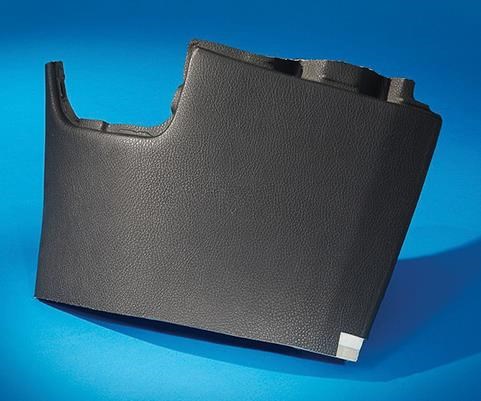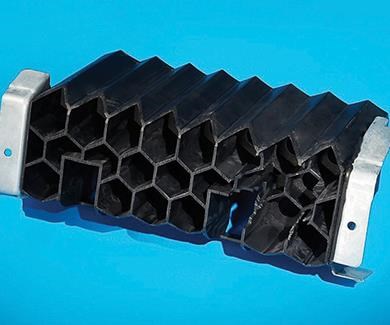Several ‘Firsts’ Among 2015 SPE Automotive Innovation Awards
CLOSE-UP: AUTOMOTIVE
Of the nine award categories, thermoplastics captured five winners.
Spanning nine categories, the winners of the SPE Automotive Division’s 2015 Blue Ribbon Automotive Innovation Awards (which this editor helped judge) represent a number of “firsts” in metal replacement and in replacing earlier plastic solutions with more capable ones. Thermoplastics played a lead role in five of the awards, which have one other thing in common—they’re all colored black. With one exception, these are functional, rather than appearance, parts.
AUTO INTERIOR: LIVING HINGE PROTECTION
The Ford 2015 F-150 pickup features a rear-seat, folding head restraint that eliminates a welded steel structure and replaces it with a single-piece thermoplastic living-hinge core as its main structural component. Tier one supplier Windsor Machine Group, LaSalle, Ont., and molder Hawk Plastics, Windsor, Ont., teamed up to design and injection mold this unique head restraint using a standard random PP copolymer from Exxon Mobil Chemical, Houston.
This single-piece plastic core results in reduced thickness from 2.56 in. to 1.26 in. for improved comfort and rear visibility, plus weight savings of 1.38 lb/vehicle, while consolidating five parts into one. Tooling costs are reduced by $180, with piece price reduced by $1.50/vehicle. This technology has been applied to the 2016 Ford Explorer and is planned for at least three additional programs.
AUTO EXTERIOR: PUSH-TO-RELEASE FASTENER
The 2015 Ford Mustang features a fastener that requires only pushing the center pin to the service position to remove—an 80% reduction in removal time, compared with other easy-service fasteners, which have two twist heads to release, along with the risk of unintentional removal. The new version brings a 10% piece-cost reduction vs. comparable service fasteners on the Mustang.
Designed and made by ITW Delta Fasteners, Troy, Mich., this fastener is made of Vydyne 47H nylon 66 from Houston-based Ascend Performance Materials. The pin and body are designed not to be easily separated; however, the fastener is reusable, unlike other push pins that become damaged in the process of removal.
The chance of unintended release is reduced because it cannot back out or be removed without a customer’s deliberate action.
POWERTRAIN: HEATED-TIP FUEL INJECTOR
The 2015 Honda Fit subcompact and Honda City vehicles sold in Brazil feature a heated-tip port fuel injector that improves cold-start performance in ethanol-fueled vehicles. Its development was a joint effort between Honda Motors, Delphi Automotive (U.S. office in Troy, Mich.) and DuPont Automotive, Wilmington, Del. The Delphi Multec 3.5 technology addresses an issue that has plagued vehicles that run on 100% ethanol (E100): This fuel will not form a combustible vapor at temperatures below 55 F, so engine-starting is not possible with a conventional System. Automakers have had to add a second gasoline fuel system for starting at colder temperatures.
The new component has an electrical heater within the injector, which is energized by the vehicle controller, rapidly heating the ethanol fuel and dramatically improving vaporization while reducing emissions. This device saved $60/vehicle as well as 19.84 lb, and lowered costs significantly by eliminating a secondary gasoline sub-tank system. The heater consists of electrical circuitry printed onto the plastic injector body.
Keys to this development were the ink materials (dielectric, conductive, and resistive inks), selected for their specific thermal and adhesive properties and performance, as well as the thick-film ink-printing process. The overmold material sealed the injector. DuPont developed a high performance polyphthalamide (PPA), Zytel HTN54G35EF BKB336, to withstand heater temperatures without degradation. It is designed with low halide ion content and heat stabilization, as well as compatibility with the unique heater inks.
PROCESS/ASSEMBLY/ENABLING TECHNOLOGIES: TPO INSTRUMENT PANEL
Hyundai Motor’s 2014 Hyundai i20 supermini features the soft IMX TPO instrument panel (IP) that eliminates scratches and a hard plastic feel. Hyundai America Tech Center, Inc., Superior Township, Mich., worked with Taiwan’s tier one supplier Hyundai-Mobis, South Korean molder Hanil E-hwa, and Korean materials supplier Hanwha L&C to bring this IP to fruition by a two-shot process. A foil is back-foamed with Multiflex 3202 TPO, which is injection-compression molded with the filled PP substrate, and is then integrated with the TPO passenger-side airbag door in a second injection step. All the work is done in a single tool. The part saves $10/vehicle and reduces mass by 0.66 lb through integration of the airbag door.
SAFETY: FLOOR ROCKER REINFORCEMENT
The 2015 Jeep Renegade SUV from FCA features an industry-first plastic-metal hybrid alternative to steel floor-rocker reinforcements, which saves 45% (2.2 lb) in weight and 10% in cost. FCA worked with Italy’s tier one Proma Group, injection molder Redstamp Srl, and materials supplier SABIC in Houston, to develop this unique component.
The application involved a Noryl GTX 910 polymer alloy of PPE and nylon 6. An optimized honeycomb geometry in this plastic/metal hybrid proved to be a very efficient energy-absorbing crash-box structure. The result is a component that is E-coat capable and also very easy to assemble into the vehicle’s BIW (body-in-white or shell). Because the plastic honeycomb is integrally attached to two steel flanges during injection molding, no structural adhesives are needed.
Related Content
Density & Molecular Weight in Polyethylene
This so-called 'commodity' material is actually quite complex, making selecting the right type a challenge.
Read MoreFundamentals of Polyethylene – Part 3: Field Failures
Polyethylene parts can fail when an inappropriate density is selected. Let’s look at some examples and examine what happened and why.
Read MoreFundamentals of Polyethylene – Part 6: PE Performance
Don’t assume you know everything there is to know about PE because it’s been around so long. Here is yet another example of how the performance of PE is influenced by molecular weight and density.
Read MoreFormulating LLDPE/LDPE Blends For Abuse–Resistant Blown Film
A new study shows how the type and amount of LDPE in blends with LLDPE affect the processing and strength/toughness properties of blown film. Data are shown for both LDPE-rich and LLDPE-rich blends.
Read MoreRead Next
Troubleshooting Screw and Barrel Wear in Extrusion
Extruder screws and barrels will wear over time. If you are seeing a reduction in specific rate and higher discharge temperatures, wear is the likely culprit.
Read MoreAdvanced Recycling: Beyond Pyrolysis
Consumer-product brand owners increasingly see advanced chemical recycling as a necessary complement to mechanical recycling if they are to meet ambitious goals for a circular economy in the next decade. Dozens of technology providers are developing new technologies to overcome the limitations of existing pyrolysis methods and to commercialize various alternative approaches to chemical recycling of plastics.
Read MoreLead the Conversation, Change the Conversation
Coverage of single-use plastics can be both misleading and demoralizing. Here are 10 tips for changing the perception of the plastics industry at your company and in your community.
Read More































